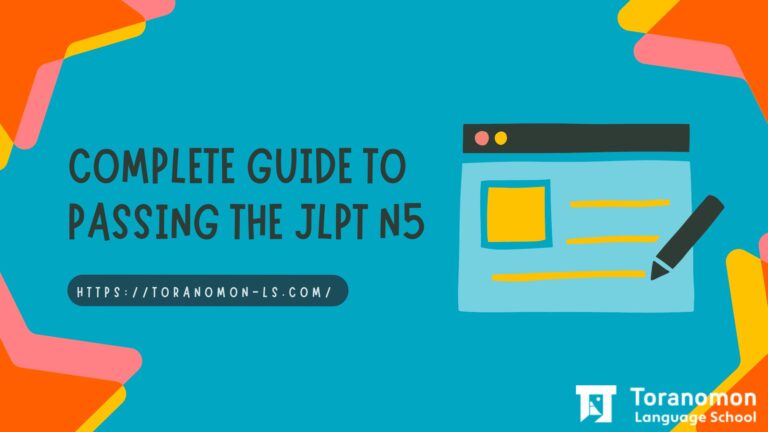Prepare for the JLPT N5 exam with this comprehensive guide! Learn all about the structure of the test, study techniques and more to successfully pass in 2023.
Are you ready to take the JLPT N5 exam? This comprehensive guide will help you understand the structure of the exam, prepare with effective study techniques and gain the confidence to pass this test, as well as what Toranomon Language School can offer you to help you with your studies.

What is the JLPT?
What exactly is the JLPT? The JLPT, also known as the Japanese-Language Proficiency Test or 日本語能力試験, is an exam designed to measure the Japanese proficiency of non-native Japanese speakers. It’s commonly used by universities and employers both in and outside Japan, and it’s offered twice a year within Japan, as well as in a few other countries. Those who plan on living, working, or studying in Japan often take the JLPT exams to demonstrate their Japanese language skills.
There are five different levels of the JLPT: N1, N2, N3, N4, and N5, with N5 being the most basic and N1 being the most advanced. The N4 and N5 levels test basic Japanese learned from a textbook, while N1 and N2 are much more advanced and test takers can usually hold their own in the language by that point. The N3 level is somewhere in between.
Is there any point in taking the JLPT N5?
For those seeking employment in Japan, JLPT scores can be quite useful. Passing the N2 or N1 levels can even qualify individuals for preferential treatment when immigrating to Japan, or get you noticed by a potential employer.
While not useful for employment, the N5 Exam can still be a valuable goal for beginner Japanese learners. It can serve as a short-term target and help learners discover their strengths and weaknesses. Furthermore, achieving the JLPT N5 level has recently become necessary in certain cases when applying for specific types of student visas to Japan.
An overview of the JLPT N5
The JLPT N5 exam tests you on some of the most basic aspects of the Japanese language. This includes your knowledge of hiragana, katakana and easy kanji. You should be able to read simple sentences and understand slow oral conversations about everyday topics.
There are three sections on the exam:
1) Vocabulary (kanji, spelling, expressions and paraphrases)
2) Grammar and Reading (forming sentences, using the right verb form, basic texts and reading comprehension)
3) Listening
For the JLPT N5 exam you will need to know around 800 vocabulary words as well as the first 100 kanji.
The vocabulary will be basic words like weather, jobs, hobbies – words used in daily life. The 100 kanji will be the most basic, like numbers, days of the week and simple verbs.
You will also need to know simple grammar, like which particle (は、が, etc) to use when, as well as verb conjugation (-masu, -mashita, etc)
How is the JLPT N5 scored? What’s the pass mark?
Vocab, grammar and reading can give you a total of 120 points, while the listening section is out of 60 points. So your overall score will be between 0-180 points, with a pass being 80+ points.
Vocabulary, grammar, reading: 0-120 points
Listening: 0-60 points
Total score: 0-180 points
Pass: 80 points (must have 38 points in Vocabulary, grammar, reading and 19 points in listening to pass)
How long is the exam?
Each section has a different time length.
Vocabulary – 20 minutes
Grammar and reading – 40 minutes
Listening – 30 minutes
The exam lasts for 1.5 hours in total.
Here are the main points to remember when revising for the JLPT N5
⚫ Get familiar with the JLPT N5 structure and content
Before starting to study for the JLPT N5 exam, you should first be familiar with the structure and types of questions it will include. The test is divided into three sections that assess your knowledge of vocabulary, grammar, reading comprehension and listening ability. Each section consists of multiple-choice and written pieces that range in difficulty level. We have detailed the N5 structure above, but we advise you to obtain some past papers to really get a feel for the test structure.
If you want help from a Japanese teacher in your preparation, TLS has a special JLPT crash course.
⚫ Learn essential Japanese grammar and vocabulary
Japanese grammar and vocabulary are essential components of the N5 exam. To prepare for the test, make sure to review basic vocabulary for topics such as pronouns, nouns, question words, adjectives and modifiers. There are plenty of resources for this on the Web, such as this list https://www.jlptstudy.net/N5/?vocab-list.
Remember to become familiar with any special expressions or phrases related to the language that are commonly used in Japan (like “mata ashita!”
For the kanji aspect, possibly the most difficult part of the test, Toranomon Language School offers a kanji prep course for those needing an extra boost.
As well as the 7-800 vocabulary words, you should also focus on learning verbs in various conjugations and practice sentences with these verbs to strengthen your comprehension levels.
⚫ Utilize JLPT N5 preparation materials effectively
When preparing for the JLPT N5 exam, utilize flashcards, practice tests, worksheets and grammar books specifically tailored to the N5 exam. If you are studying hard but find yourself stuck on a certain concept or vocabulary word, consider an online resource or forum for additional help. Additionally, many online courses now offer access to virtual classrooms which can be beneficial for learning with peers, asking questions and getting feedback from an instructor.
⚫ Develop strategies for each kind of question in advance of the test day
Developing a set of strategies for each type of question helps to ensure that you approach the exam with an effective plan. Take the time to review all types of questions and use practice tests to practice different approaches, such as memorizing kanji or vocab words faster, understanding grammar patterns quickly and efficiently, or finding information quickly in a passage. For example, you could read the questions before reading the passage, so that you know what the key points are when reading the text.
Your course teacher at Toranomon Language School can help you strategize if you enroll in a course.
⚫ On the day
Remember to arrive early (any time from 11:45am) and bring your pencils, erasers, test voucher, and a watch. When you arrive, show your voucher and staff will direct you to a room.

